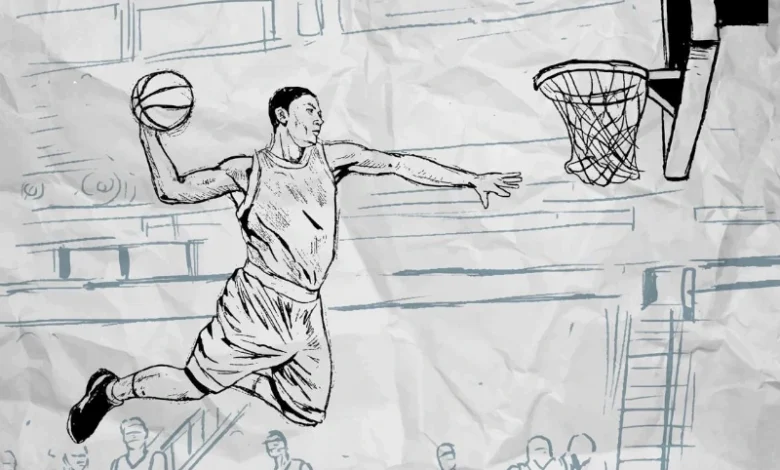From Court to Canvas: How to drawing:_tpnhdiv3r8= basketball

Basketball is more than just a game; it’s a culture, an emotion, and for many, a passion that transcends the court. The thrill of the slam dunk or the precision of a three-pointer captures our hearts and inspires creativity in various forms. One such artistic expression is drawing basketball—an exciting fusion of sport and art that allows fans to translate their love for the game into something visually stunning. Whether you’re sketching your favorite player mid-air or capturing the dynamic energy of a fast break, there’s an undeniable connection between hoops and artistic flair. Join us as we explore how to transform your appreciation for basketball into breathtaking drawings that leap off the canvas!
The Intersection of drawing:_tpnhdiv3r8= basketball
Drawing basketball uniquely captures the essence of movement and emotion found in the game. The swish of the net, the intensity on players’ faces, and the energy of a packed arena can all be translated onto paper.
Artists find inspiration in every dribble and shot. Each line drawn reflects not just skill but also passion. This intersection creates a visual narrative that brings fans closer to their favorite sport.
The act of drawing allows for personal interpretation. Whether focusing on a player’s form or illustrating an entire scene from a championship game, each piece becomes a storyteller.
With each stroke, artists bridge two worlds: athleticism and creativity. It invites viewers into an experience where they can feel both exhilarated by competition and captivated by artistry—where court dynamics meet canvas brilliance.
The History of Basketball in Art
Basketball has long transcended the boundaries of the court, finding its place in various forms of art. From early illustrations to contemporary murals, the sport’s dynamic movement and energy inspire countless artists.
In the 1940s and 1950s, basketball gained popularity among painters who sought to capture its vibrant spirit. Iconic works emerged that showcased athletes in action. Artists portrayed not just the game but also its cultural significance during this era.
The rise of street art introduced a new wave of expression centered around basketball culture. Murals celebrating legendary players adorned urban landscapes, transforming neighborhoods into canvases.
Photographers have also played a pivotal role in immortalizing moments on and off the court. Their images depict raw emotion—joyous celebrations or heartbreaking defeats—illustrating how deeply intertwined basketball is with human experience.
As time evolves, so does artistic interpretation, ensuring that basketball remains a captivating subject across all mediums.
Understanding the Basics of drawing:_tpnhdiv3r8= basketball
To start your journey in drawing basketball, grasp the basic shapes. A basketball is fundamentally a sphere. Begin with a perfect circle to set the foundation.
Next, consider perspective. Depending on your angle, the ball might appear more oval than round. Sketch lightly at first; this will help you adjust without frustration.
Now comes texture and lines. The iconic grooves of a basketball add character. Using gentle curves for these details elevates realism.
Think about proportion too—how big should it be relative to figures or surroundings? Experiment with different sizes until it feels right.
Don’t forget about movement! Adding energy suggests that players are in action rather than just standing still. This brings life to your artwork and captivates viewers’ attention effortlessly.
Tips and Techniques for Drawing a Basketball
Start by sketching a basic circle. This forms the foundation of your basketball drawing. Use light pencil strokes; you can refine them later.
Next, add the iconic lines that define a basketball’s surface. These curves give it depth and character. Pay attention to how they intersect and create an illusion of three-dimensionality.
Use reference images for accuracy. Study different angles and perspectives to enhance your understanding of shape.
When you’re ready, choose your colors wisely. A vibrant orange with subtle shading will make your drawing pop off the page.
Don’t forget about texture! Adding tiny details like scuff marks or signs of wear brings authenticity to your piece.
Experiment with various mediums too—colored pencils, markers, or even watercolors can yield unique results that reflect your personal style in capturing this beloved sport on canvas.
Taking Your Drawing to the Next Level: Adding Shadows and Details
Adding shadows and details can transform your basketball drawing from basic to breathtaking. Shadows create depth, making the ball feel three-dimensional.
Start by identifying a light source. This will guide where you place darker tones on your drawing. Use a softer pencil or charcoal for shading; it blends beautifully and allows for subtle transitions.
Incorporate texture into the basketball’s surface. Draw small lines to represent the leather panels and use varying pressure to differentiate between highlights and shadows.
Don’t forget about reflections! A hint of shine can elevate realism, mimicking how light bounces off the ball’s surface.
Take time with these elements; they breathe life into your artwork. Each detail adds character, echoing the spirit of the game itself—dynamic and full of energy.
Turning Your Drawing into a Work of Art
Once you’ve sketched your basketball drawing, it’s time to elevate it. Start by refining your outlines. Use a darker pencil or ink to emphasize the key features. This adds depth and draws the eye.
Next, consider adding color. Whether you choose traditional orange for the ball or experiment with vibrant hues, color can breathe life into your artwork. Watercolors and colored pencils are great options for blending shades seamlessly.
Textures play a crucial role as well. Incorporate elements like rough surfaces for the court or smoothness on the ball’s surface. These details make your art pop.
Don’t shy away from personal touches that reflect your style—perhaps abstract lines representing motion or dynamic backgrounds that capture energy.
Frame your piece thoughtfully; presentation matters just as much as execution in showcasing your passion and creativity through art.
Conclusion: The Power of Combining Passion and Creativity
When we merge our love for drawing:_tpnhdiv3r8= basketball with the world of art, something magical happens. The court becomes a source of inspiration that translates into vibrant drawings. Each line and curve captures not just the shape of the ball or player but also the essence of movement, energy, and emotion.
Drawing is more than technique; it’s about passion. Whether you’re sketching during halftime or creating a masterpiece in your studio, every stroke reflects your connection to the sport you adore. Embracing both creativity and athleticism can breathe new life into your artwork.
This fusion allows us to express our unique experiences on and off the court. As you explore different styles and techniques in drawing basketball scenes or players, remember that each piece tells a story—your story. It’s an opportunity to share your journey through art while celebrating what makes basketball special to you.
So grab those pencils or brushes! Dive deep into this artistic endeavor where passion meets creativity on every canvas. You may find that expressing love for basketball through drawing opens up avenues you never imagined possible.





